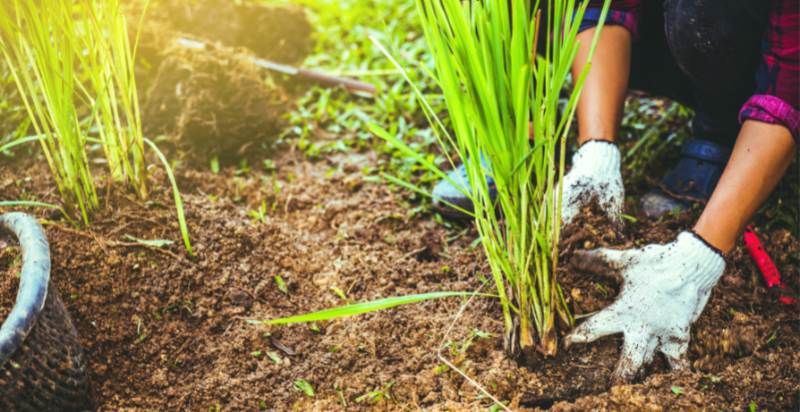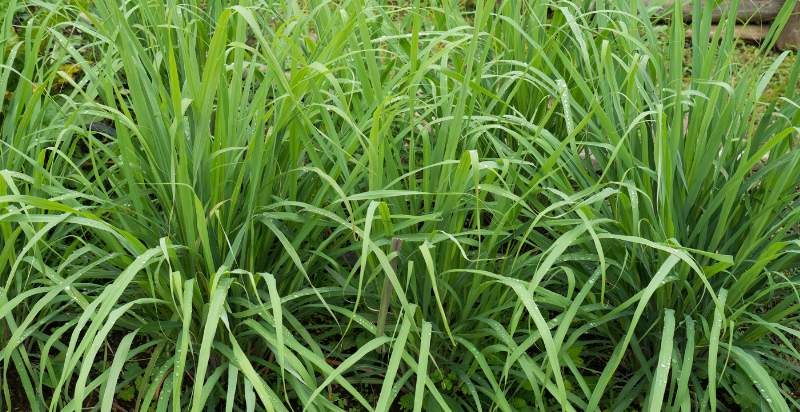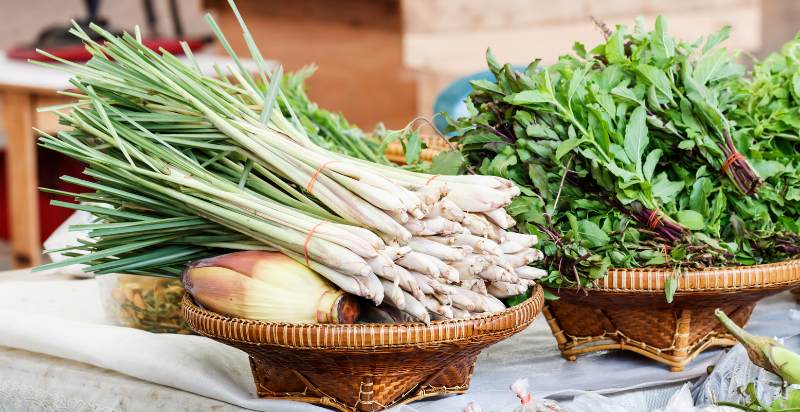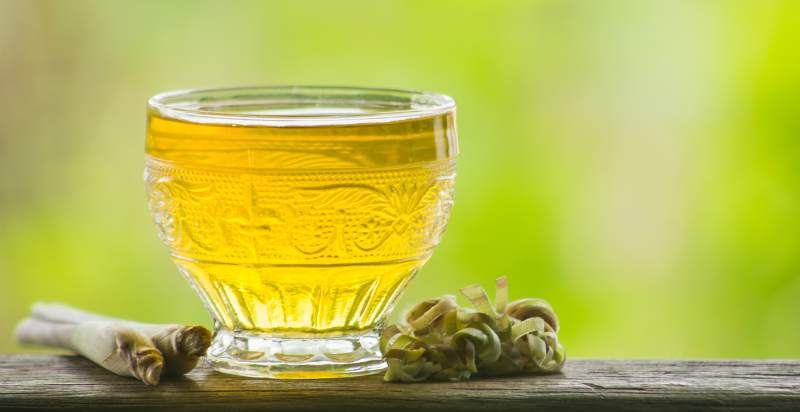Lemongrass, also known as Cymbopogon citratus and Andropogon citratus, is a type of grass native to tropical regions in Asia, Africa, Australia, and other parts of the world. The plant has long been used as an herb for medicinal purposes in traditional medicine.
It is primarily used as an essential oil in aromatherapy, as a flavoring agent in cooking and baking, and as an herbal tea. It is also used in many skincare products due to its antibacterial, antifungal, anti-inflammatory, and antioxidant properties. Here is everything you wanted to know about lemongrass.
What is Lemongrass?
Lemongrass is a perennial grass with long, narrow leaves and an aromatic, citrus-like scent. It grows up to four feet tall and has clusters of small white flowers that can be used in cooking or dried for medicinal uses. The plant is a member of the Cymbopogon family and is native to India, Southeast Asia, and parts of Africa.
History and Origin of Lemongrass:
Lemongrass has been used in traditional medicine for centuries, especially in India and Southeast Asia. It is believed to have originated in the Indian subcontinent and is now cultivated worldwide. In Ayurveda, lemongrass is thought to have a balancing effect on the body’s three doshas (energy types).
Types of Lemongrass:
There are two main types of lemongrass: Citronella and Lemongrass. Citronella is the most common variety, and it has a strong lemon scent used for flavoring foods and teas. Lemongrass has a more subtle citrus flavor and is often used as an herbal remedy for various ailments such as colds, headaches, and joint pain.
Nutritional Value of Lemongrass:
Lemongrass is a good source of many vitamins and minerals, including vitamins A, B6, C, K, iron, and magnesium. It also contains antioxidants that may help protect cells from damage caused by free radicals. In addition to these nutrients, lemongrass has been found to have antifungal, anti-inflammatory, and antibacterial properties.
Uses of Lemongrass:
Lemongrass is a fragrant and flavorful herb that is used in many cuisines around the world. It has a strong citrus flavor and aroma, making it an excellent addition to savory and sweet dishes. Lemongrass can be used fresh, dried, or as an essential oil for medicinal purposes.
In Southeast Asian cooking, lemongrass is often used in soups, curries, marinades, and as a garnish for salads. It can also be added to teas or steeped in hot water for a refreshing beverage. Many also enjoy adding lemongrass to smoothies or herbal potions to boost flavor.
In traditional medicine, lemongrass is often used to treat colds, flu, indigestion, headaches, and cramping. It can also be used as a natural insect repellent due to its citrus scent. Its essential oil can be used for aromatherapy or topically for muscle pain relief.
Lemongrass contains antioxidants, vitamins A, B1, B2, and C, and minerals like calcium, phosphorus, and magnesium. It has anti-inflammatory properties, which can help soothe sore throats and reduce fevers. It can also help relieve stress and anxiety by calming the nervous system.
Overall, lemongrass is a versatile herb that can be used in many different ways. Whether it’s being added to dishes for flavor, used in teas for medicinal purposes, or just enjoyed as an essential oil for aromatherapy, lemongrass provides many benefits.
How to Plant Lemongrass?
Lemongrass is a fragrant grass with a lemon scent and flavor. It is an important ingredient in many cuisines worldwide, from East Asian to Southeast Asian dishes. Lemongrass can be used for flavoring teas, soups, curries, and even cocktails! Growing lemongrass is easy and can also be done indoors. Here are some tips on how to plant lemongrass and keep it healthy.
Choosing the Right Soil:
When planting lemongrass, you should choose fertile soil that drains well and has a pH of 6-7. If your soil is too acidic, add lime or other amendments to raise the pH level. Make sure plenty of organic matter, such as compost or aged manure, is mixed into the soil for better growth.
Preparing the Planting Area:
Before planting, clear any weeds from the area and loosen up the soil with a garden fork or tiller so that it’s easier for the roots to spread, add some fertilizer, such as bone meal or other organic material, to the soil before planting.
Planting:
Lemongrass is best planted from a root division or started from a seed. To plant a root division:
- Place one foot in each hole and cover it with soil up to the base of the leaves.
- Make sure you don’t plant too deep; lemongrass grows best when planted shallowly.
- If planting from seed, sow them in small groups about an inch apart at a depth of ½-1 inch and keep them moist until germination occurs.
Once your lemongrass has been planted, it will need regular watering and sunlight to be healthy. Water the plants deeply, but don’t overwater them. Place an inch or two of mulch around the plants to help conserve soil moisture and reduce weeds.
It would help if you also fertilized your lemongrass every four to six weeks with a balanced fertilizer, such as 10-10-10. If you want more flavor in your lemongrass, add some organic matter before each feeding.
Lemongrass can be harvested when it is 12 inches tall or longer. Cut the stalks at their base with pruning shears or scissors and discard any damaged leaves or stems. The stalks can then be used fresh or dried for later use.
Lemongrass is a flavorful and versatile grass easily grown in the garden. With some soil preparation, regular watering, and fertilizing, you’ll have plenty of lemongrasses to add flavor to your dishes! Whether you’re growing it indoors or outdoors, remember to keep an eye on your lemongrass plants, so they stay healthy and productive.

How to Care for and Grow Lemongrass?
Lemongrass is a fragrant and flavorful herb used in many dishes worldwide. It has a distinct citrusy aroma and taste, making it an attractive addition to any recipe. It can be used fresh or dried, but it’s important to care for lemongrass to get the most out of this wonderful plant. Here are some tips on how to grow and care for lemongrass:
- Planting: Lemongrass prefers warm climates with plenty of sun exposure and well-draining soil. If you live in a cooler climate, you may need to start your plants indoors during winter before moving them outdoors when temperatures rise. Plant seeds or cuttings in a container filled with soil. Plant them about 1-2 inches deep and water them well.
- Watering: Lemongrass needs plenty of water to keep it growing healthy and strong. Water regularly, making sure the soil is always moist but not soggy. If you live in a dry climate, you may need to water more frequently. In some climates, you may also want to mist your lemongrass plants regularly to increase humidity levels around the plants.
- Fertilizing: Feed your lemongrass plants once every two weeks during its active growing season (spring through fall). A balanced liquid fertilizer is ideal for fertilizing your lemongrass plants; however, you can also use organic fertilizers such as compost or fish emulsion.
- Harvesting: The leaves of the lemongrass plant can be harvested anytime throughout the growing season, but it is best to wait until the plant is at least a foot tall before harvesting any leaves. To harvest, trim off the bottom of the stalks and then use scissors to snip off individual leaves or bunches of leaves from near their base.
With proper care and attention, you can enjoy fragrant lemongrass in your garden for years to come. Whether you want to use it fresh in dishes or dry it for later use, taking good care of your plants will ensure you get the maximum flavor and aroma out of your lemongrass plants.

Preventions from Pests and Diseases:
Unfortunately, lemongrass is prone to several pests and diseases. The best way to prevent any issue with your plants is to practice good garden hygiene by removing any dead or dying leaves and any weeds that may be competing with the lemongrass. Additionally, be sure to water at ground level rather than from above to reduce water splashing onto the leaves, which can spread disease.
If you notice any issues with your plants, such as yellowing of the leaves or discoloration of stems, treat them immediately with a suitable insecticide or fungicide. Be sure to follow all instructions on the product label for the safe application and correct dosage.
For extra protection against pests and diseases, cover your lemongrass plants with a floating row cover during the warm months. This will help keep out unwanted pests while allowing sunlight and air to reach the plants.
How to Harvest a Lemongrass Plant?
Harvesting lemongrass is simple and easy, but it’s important to wait until the plant is at least a foot tall before harvesting any leaves. Cut off the bottom of the stalk to harvest, and then use scissors to snip off individual leaves or bunches of leaves from near their base.
After harvesting, you can use the fresh lemongrass immediately in recipes or dry it later. If drying your lemongrass, spread the leaves on a sheet tray lined with parchment paper and place them inside a dehydrator set at 105°F (41°C). Check periodically until they are completely dry; this usually takes about 8-10 hours. Once fully dried, store in an airtight container for up to 1 year.
With proper care and attention, you can enjoy fragrant lemongrass in your garden for years to come.

How to Store Lemongrass?
If you have harvested or purchased more lemongrass than you can use immediately, storing it correctly will help keep it fresh for future use. Freshly harvested lemongrass should be kept refrigerated and wrapped in a damp paper towel or sealed plastic bag in the refrigerator’s crisper drawer. It will last up to two weeks when stored this way.
If you plan on using the lemongrass later, freezing it is the best way to preserve it. To freeze lemongrass, trim any leaves near the base and discard them, then chop or mince the stalk into small pieces before placing them in a freezer-safe container or bag. When needed, thaw out however much you need for your recipe! Frozen lemongrass can last up to 6 months when stored properly.
How to Use Lemongrass?
Lemongrass is an aromatic herb used in many Asian cuisines. It adds a unique citrusy flavor to dishes and has long been prized for its medicinal properties. When using lemongrass, it’s important to prepare it properly for the best results. Here are some tips on how to use lemongrass:
- Choose fresh lemongrass – Whenever possible, purchase fresh lemongrass from your local grocery store or farmer’s market. Avoid any bulbs that appear wilted or dried out, as they will not have the same strong flavor as fresh ones.
- Peel off the outer layers – Before using your lemongrass, remove the tough outer leaves. Use a sharp knife or kitchen scissors to cut away any dry or browned parts of the lemongrass stalks and discard them.
- Cut into pieces – Chop your lemongrass into small, thin slices, about 1/4-inch thick each. If you prefer larger chunks for soups, stews, and curries, you can also choose to mince the bulb instead.
- Add to dishes – Once prepped, add your lemongrass to your dishes, such as stir-fries, soups, sauces, and marinades. You can also steep it in hot water to make a flavorful tea.
- Store unused lemongrass – If you have leftover lemongrass, wrap it up in a damp paper towel and place it in an airtight container or plastic bag. This will help keep the herb fresh for several days before needing to be used.
Using lemongrass is easy and a great way to add flavor, nutrition, and complexity to your dishes.

Potential Risks from Lemongrass:
Although lemongrass is generally considered safe for most people, it can cause some side effects. For example, lemongrass oil may cause skin irritation and allergic reactions in some individuals. Additionally, ingesting large amounts of lemongrass may lead to stomach upset and nausea.
Finally, those who are pregnant or breastfeeding should avoid consuming large amounts of lemongrass as it has not been tested for safety in these cases. It’s always best to consult a doctor before adding any new food or supplement to your diet.
Conclusion:
Lemongrass is an aromatic herb that adds a unique flavor to dishes. Knowing how to use and store this herb properly will help ensure the best cooking results. Just be sure to limit your intake if you are pregnant or breastfeeding, as it is not known to be safe for these populations.
With its bright, citrusy flavor and many health benefits, lemongrass has become increasingly popular. If you want to use this flavorful herb in your cooking, learning to prepare and store it correctly will help ensure the best results. With these tips on how to use and store lemongrass, you can enjoy this herb’s taste and health benefits any time!
Enjoy the flavor and benefits of lemongrass in your meals today!
- Everything You Wanted to Know About Red Tamarillos - June 2, 2025
- A Guide to Tulips: Everything You Need to Know & More… - June 2, 2025
- Guanabana: Description, Flavor, Benefits, And Uses - May 27, 2025

5 thoughts on “What is Lemongrass? How to Plant, Grow, and Harvest Lemongrass”
Comments are closed.